NumPy中的ones和zeros函数:创建特殊数组的利器
NumPy是Python中用于科学计算的核心库,它提供了许多强大的工具和函数来处理多维数组和矩阵。在NumPy中,ones和zeros是两个非常实用的函数,它们用于创建特定形状的数组,其中所有元素分别被初始化为1或0。这两个函数在数据预处理、初始化模型参数、创建掩码等场景中都有广泛的应用。本文将深入探讨NumPy中的ones和zeros函数,介绍它们的用法、参数、返回值以及在实际编程中的应用场景。
1. NumPy中的ones函数
numpy.ones函数用于创建一个新的数组,其中所有元素都被初始化为1。这个函数非常灵活,可以创建不同维度和数据类型的数组。
1.1 基本用法
ones函数的基本语法如下:
numpy.ones(shape, dtype=None, order='C')
其中:
– shape:指定数组的形状,可以是一个整数(表示一维数组的长度)或一个整数元组(表示多维数组的形状)。
– dtype:可选参数,指定数组的数据类型。默认为numpy.float64。
– order:可选参数,指定数组在内存中的存储顺序,’C’表示行优先(C风格),’F’表示列优先(Fortran风格)。
让我们看一些基本的例子:
import numpy as np
# 创建一个一维数组
one_d = np.ones(5)
print("One-dimensional array from numpyarray.com:", one_d)
# 创建一个二维数组
two_d = np.ones((3, 4))
print("Two-dimensional array from numpyarray.com:", two_d)
# 创建一个三维数组
three_d = np.ones((2, 3, 4))
print("Three-dimensional array from numpyarray.com:", three_d)
Output:
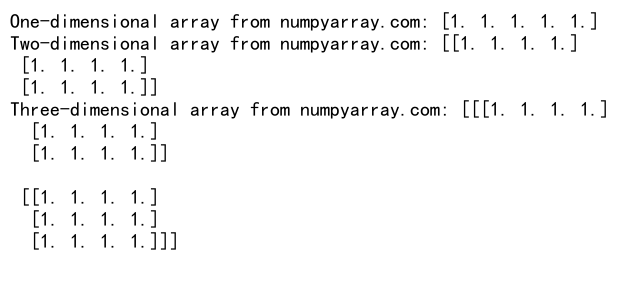
在这个例子中,我们分别创建了一维、二维和三维的数组,所有元素都被初始化为1。注意二维和三维数组的形状是如何用元组指定的。
1.2 指定数据类型
ones函数允许我们指定数组的数据类型。这在需要控制内存使用或确保数值精度时非常有用。
import numpy as np
# 创建一个整数类型的数组
int_array = np.ones(5, dtype=int)
print("Integer array from numpyarray.com:", int_array)
# 创建一个复数类型的数组
complex_array = np.ones(5, dtype=complex)
print("Complex array from numpyarray.com:", complex_array)
# 创建一个布尔类型的数组
bool_array = np.ones(5, dtype=bool)
print("Boolean array from numpyarray.com:", bool_array)
Output:

这个例子展示了如何创建不同数据类型的数组。整数类型的数组中所有元素都是1,复数类型的数组中所有元素都是1+0j,布尔类型的数组中所有元素都是True。
1.3 使用ones函数初始化矩阵
ones函数在初始化矩阵时非常有用,特别是在需要创建单位矩阵或特定模式的矩阵时。
import numpy as np
# 创建一个3x3的单位矩阵
identity_matrix = np.ones((3, 3)) * np.eye(3)
print("Identity matrix from numpyarray.com:")
print(identity_matrix)
# 创建一个上三角矩阵
upper_triangular = np.ones((4, 4)) * np.triu(np.ones((4, 4)))
print("Upper triangular matrix from numpyarray.com:")
print(upper_triangular)
Output:
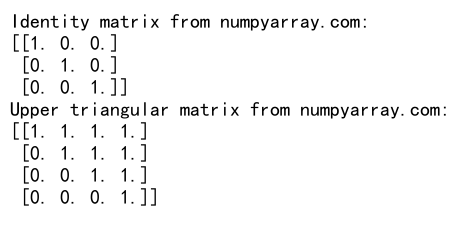
在这个例子中,我们首先创建了一个3×3的单位矩阵,然后创建了一个4×4的上三角矩阵。np.eye函数用于创建对角线为1的矩阵,np.triu函数用于创建上三角矩阵。
1.4 ones函数在数据预处理中的应用
在数据预处理中,ones函数常用于添加偏置项或创建特征矩阵。
import numpy as np
# 假设我们有一个特征矩阵
X = np.array([[1, 2], [3, 4], [5, 6]])
# 添加偏置项
X_with_bias = np.column_stack((np.ones(X.shape[0]), X))
print("Feature matrix with bias term from numpyarray.com:")
print(X_with_bias)
# 创建one-hot编码
num_classes = 3
num_samples = 4
one_hot = np.eye(num_classes)[np.random.choice(num_classes, num_samples)]
print("One-hot encoding from numpyarray.com:")
print(one_hot)
Output:
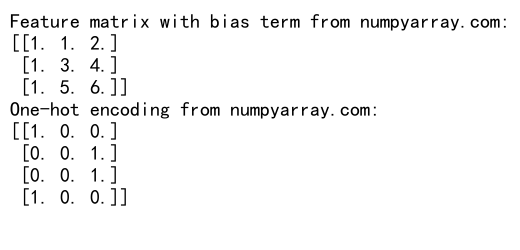
在这个例子中,我们首先向特征矩阵添加了一列1作为偏置项。然后,我们使用np.eye和ones函数的组合创建了一个one-hot编码矩阵。
2. NumPy中的zeros函数
numpy.zeros函数用于创建一个新的数组,其中所有元素都被初始化为0。这个函数的用法与ones函数非常相似。
2.1 基本用法
zeros函数的基本语法如下:
numpy.zeros(shape, dtype=float, order='C')
参数的含义与ones函数相同。让我们看一些基本的例子:
import numpy as np
# 创建一个一维数组
zero_1d = np.zeros(5)
print("One-dimensional zero array from numpyarray.com:", zero_1d)
# 创建一个二维数组
zero_2d = np.zeros((3, 4))
print("Two-dimensional zero array from numpyarray.com:", zero_2d)
# 创建一个三维数组
zero_3d = np.zeros((2, 3, 4))
print("Three-dimensional zero array from numpyarray.com:", zero_3d)
Output:
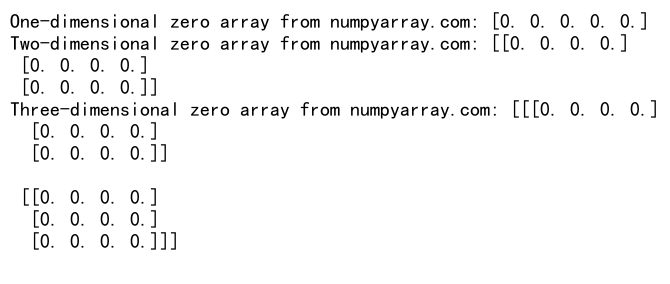
这个例子创建了一维、二维和三维的零数组,所有元素都被初始化为0。
2.2 指定数据类型
与ones函数一样,zeros函数也允许我们指定数组的数据类型。
import numpy as np
# 创建一个整数类型的零数组
int_zeros = np.zeros(5, dtype=int)
print("Integer zero array from numpyarray.com:", int_zeros)
# 创建一个复数类型的零数组
complex_zeros = np.zeros(5, dtype=complex)
print("Complex zero array from numpyarray.com:", complex_zeros)
# 创建一个布尔类型的零数组
bool_zeros = np.zeros(5, dtype=bool)
print("Boolean zero array from numpyarray.com:", bool_zeros)
Output:

这个例子展示了如何创建不同数据类型的零数组。整数类型和复数类型的数组中所有元素都是0,布尔类型的数组中所有元素都是False。
2.3 使用zeros函数初始化矩阵
zeros函数在初始化矩阵时也非常有用,特别是在需要创建稀疏矩阵或特定模式的矩阵时。
import numpy as np
# 创建一个稀疏矩阵
sparse_matrix = np.zeros((5, 5))
sparse_matrix[0, 0] = 1
sparse_matrix[2, 2] = 1
sparse_matrix[4, 4] = 1
print("Sparse matrix from numpyarray.com:")
print(sparse_matrix)
# 创建一个下三角矩阵
lower_triangular = np.zeros((4, 4)) + np.tril(np.ones((4, 4)))
print("Lower triangular matrix from numpyarray.com:")
print(lower_triangular)
Output:

在这个例子中,我们首先创建了一个稀疏矩阵,只有对角线上的某些元素为1,其余元素为0。然后,我们创建了一个4×4的下三角矩阵。np.tril函数用于创建下三角矩阵。
2.4 zeros函数在机器学习中的应用
在机器学习中,zeros函数常用于初始化权重矩阵或创建掩码。
import numpy as np
# 初始化神经网络权重
input_size = 10
hidden_size = 5
output_size = 3
weights_input_hidden = np.zeros((input_size, hidden_size))
weights_hidden_output = np.zeros((hidden_size, output_size))
print("Input to hidden weights from numpyarray.com:")
print(weights_input_hidden)
print("Hidden to output weights from numpyarray.com:")
print(weights_hidden_output)
# 创建掩码
sequence_length = 10
batch_size = 3
mask = np.zeros((batch_size, sequence_length))
mask[:, :5] = 1 # 假设前5个时间步是有效的
print("Mask from numpyarray.com:")
print(mask)
Output:
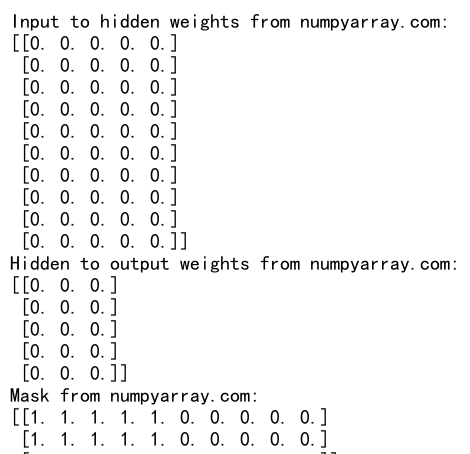
在这个例子中,我们首先使用zeros函数初始化了一个简单神经网络的权重矩阵。然后,我们创建了一个掩码,用于在序列处理任务中标记有效的时间步。
3. ones和zeros函数的高级用法
除了基本用法外,ones和zeros函数还有一些高级用法,可以帮助我们更灵活地创建和操作数组。
3.1 使用ones_like和zeros_like函数
ones_like和zeros_like函数可以创建与给定数组具有相同形状和数据类型的数组。
import numpy as np
# 创建一个示例数组
example_array = np.array([[1, 2, 3], [4, 5, 6]])
# 使用ones_like创建相同形状的全1数组
ones_array = np.ones_like(example_array)
print("Ones array from numpyarray.com:")
print(ones_array)
# 使用zeros_like创建相同形状的全0数组
zeros_array = np.zeros_like(example_array)
print("Zeros array from numpyarray.com:")
print(zeros_array)
Output:
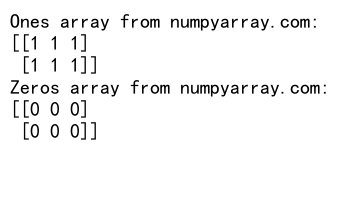
这个例子展示了如何使用ones_like和zeros_like函数创建与给定数组具有相同形状和数据类型的数组。
3.2 使用full函数创建自定义值的数组
full函数允许我们创建一个填充自定义值的数组。
import numpy as np
# 创建一个填充自定义值的数组
custom_array = np.full((3, 4), 3.14)
print("Custom value array from numpyarray.com:")
print(custom_array)
# 创建一个填充字符串的数组
string_array = np.full((2, 2), "numpyarray.com")
print("String array from numpyarray.com:")
print(string_array)
Output:

在这个例子中,我们首先创建了一个填充π值的数组,然后创建了一个填充字符串的数组。
3.3 结合ones、zeros和其他NumPy函数
我们可以将ones和zeros函数与其他NumPy函数结合使用,创建更复杂的数组结构。
import numpy as np
# 创建一个棋盘模式的数组
chessboard = np.zeros((8, 8))
chessboard[1::2, ::2] = 1
chessboard[::2, 1::2] = 1
print("Chessboard pattern from numpyarray.com:")
print(chessboard)
# 创建一个同心圆模式的数组
x, y = np.indices((10, 10))
r = np.sqrt((x - 4.5)**2 + (y - 4.5)**2)
concentric = np.zeros((10, 10))
concentric[r < 2] = 1
concentric[(r >= 2) & (r < 4)] = 0.5
print("Concentric pattern from numpyarray.com:")
print(concentric)
Output:
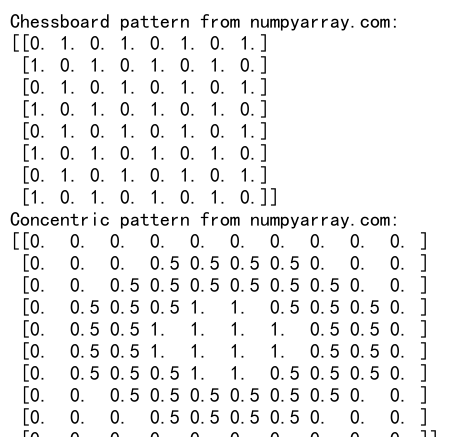
在这个例子中,我们首先创建了一个棋盘模式的数组,然后创建了一个同心圆模式的数组。这展示了如何结合ones、zeros和其他NumPy函数来创建复杂的数组结构。
4. ones和zeros函数的性能考虑
虽然ones和zeros函数非常方便,但在处理大型数组时,我们需要考虑性能问题。
4.1 内存使用
创建大型数组时,ones和zeros函数会分配相应的内存。对于非常大的数组,这可能会导致内存问题。
import numpy as np
# 创建一个大型数组
large_array = np.zeros((10000, 10000))
print(f"Memory usage of large array from numpyarray.com: {large_array.nbytes / 1e6:.2f} MB")
Output:

这个例子创建了一个10000×10000的零数组,并打印出它的内存使用量。在处理大型数据集时,我们需要注意内存使用。
4.2 使用视图提高性能
在某些情况下,我们可以使用视图来避免不必要的内存分配,从而提高性能。
import numpy as np
# 创建一个大型数组
base_array = np.zeros((10000, 10000))
# 创建一个视图
view_array = base_array.view()
view_array[:100, :100] = 1
print("Memory usage of base array from numpyarray.com:", base_array.nbytes / 1e6, "MB")
print("Memory usage of view array from numpyarray.com:", view_array.nbytes / 1e6, "MB")
Output:

在这个例子中,我们创建了一个大型零数组,然后创建了它的视图。修改视图不会创建新的数组,而是直接修改原始数组,从而节省内存。
5. ones和zeros函数在实际应用中的使用场景
ones和zeros函数在许多实际应用中都有重要作用。让我们看一些具体的例子。
5.1 图像处理
在图像处理中,ones和zeros函数常用于创建掩码或初始化图像数组。
import numpy as np
# 创建一个简单的图像掩码
image_shape = (100, 100)
mask = np.zeros(image_shape, dtype=bool)
mask[25:75, 25:75] = True
print("Image mask from numpyarray.com:")
print(mask)
# 初始化一个RGB图像数组
rgb_image = np.zeros((100, 100, 3), dtype=np.uint8)
rgb_image[:, :, 0] = 255 # 设置红色通道为最大值
print("RGB image shape from numpyarray.com:", rgb_image.shape)
print("RGB image data type from numpyarray.com:", rgb_image.dtype)
Output:
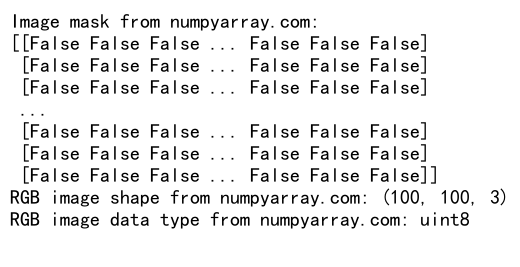
这个例子展示了如何使用zeros函数创建图像掩码和初始化RGB图像数组。
5.2 自然语言处理
在自然语言处理中,ones和zeros函数常用于创建词向量或初始化嵌入矩阵。
import numpy as np
# 创建一个简单的词嵌入矩阵
vocab_size = 1000
embedding_dim = 50
embedding_matrix = np.zeros((vocab_size, embedding_dim))
# 随机初始化一些词向量
random_words = np.random.choice(vocab_size, 10, replace=False)
embedding_matrix[random_words] = np.random.randn(10, embedding_dim)
print("Embedding matrix shape from numpyarray.com:", embedding_matrix.shape)
print("Number of initialized vectors from numpyarray.com:", np.count_nonzero(np.any(embedding_matrix, axis=1)))
Output:

这个例子展示了如何使用zeros函数初始化词嵌入矩阵,并随机初始化一些词向量。
5.3 机器学习模型初始化
在机器学习中,ones和zeros函数常用于初始化模型参数。
import numpy as np
# 初始化一个简单的神经网络层
input_size = 100
output_size = 10
weights = np.zeros((input_size, output_size))
biases = np.zeros(output_size)
print("Weights shape from numpyarray.com:", weights.shape)
print("Biases shape from numpyarray.com:", biases.shape)
# 使用Xavier初始化
xavier_weights = np.random.randn(input_size, output_size) / np.sqrt(input_size)
print("Xavier weights mean from numpyarray.com:", np.mean(xavier_weights))
print("Xavier weights std from numpyarray.com:", np.std(xavier_weights))
Output:

这个例子展示了如何使用zeros函数初始化神经网络的权重和偏置,以及如何实现Xavier初始化。
6. ones和zeros函数的注意事项和最佳实践
在使用ones和zeros函数时,有一些注意事项和最佳实践可以帮助我们更有效地使用这些函数。
6.1 数据类型的选择
选择适当的数据类型可以优化内存使用和计算性能。
import numpy as np
# 比较不同数据类型的内存使用
float64_array = np.zeros((1000, 1000), dtype=np.float64)
float32_array = np.zeros((1000, 1000), dtype=np.float32)
int8_array = np.zeros((1000, 1000), dtype=np.int8)
print("Memory usage (float64) from numpyarray.com:", float64_array.nbytes / 1e6, "MB")
print("Memory usage (float32) from numpyarray.com:", float32_array.nbytes / 1e6, "MB")
print("Memory usage (int8) from numpyarray.com:", int8_array.nbytes / 1e6, "MB")
Output:

这个例子比较了不同数据类型的内存使用情况,展示了选择合适数据类型的重要性。
6.2 避免不必要的复制
在操作大型数组时,应尽量避免不必要的复制,以节省内存和提高性能。
import numpy as np
# 创建一个大数组
large_array = np.zeros((10000, 10000))
# 不好的做法:创建副本
bad_practice = large_array.copy()
bad_practice += 1
# 好的做法:直接修改原数组
good_practice = large_array
good_practice += 1
print("Memory usage (bad practice) from numpyarray.com:", bad_practice.nbytes / 1e6, "MB")
print("Memory usage (good practice) from numpyarray.com:", good_practice.nbytes / 1e6, "MB")
Output:

这个例子展示了如何避免不必要的数组复制,从而节省内存。
6.3 使用广播来提高效率
NumPy的广播功能可以帮助我们更高效地操作数组。
import numpy as np
# 创建一个2D数组
array_2d = np.zeros((5, 3))
# 使用循环(效率较低)
for i in range(array_2d.shape[0]):
array_2d[i] = i
# 使用广播(更高效)
array_2d_broadcast = np.zeros((5, 3))
array_2d_broadcast += np.arange(5)[:, np.newaxis]
print("Array with loop from numpyarray.com:")
print(array_2d)
print("Array with broadcast from numpyarray.com:")
print(array_2d_broadcast)
Output:
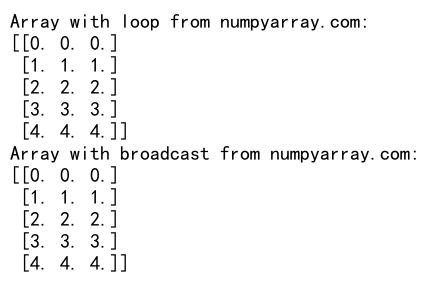
这个例子展示了如何使用广播来更高效地操作数组,避免使用循环。
结论
NumPy的ones和zeros函数是创建特殊数组的强大工具。它们在数据预处理、模型初始化、图像处理等多个领域都有广泛应用。通过本文的详细介绍和丰富的示例,我们深入了解了这两个函数的用法、参数、返回值以及在实际编程中的应用场景。掌握这些函数的使用技巧,可以帮助我们更高效地处理数组和矩阵,提高科学计算和数据分析的效率。在实际应用中,我们还需要注意性能优化,选择合适的数据类型,避免不必要的复制,并善用NumPy的广播功能。通过灵活运用ones和zeros函数,我们可以更好地应对各种数据处理和科学计算的挑战。
 极客笔记
极客笔记